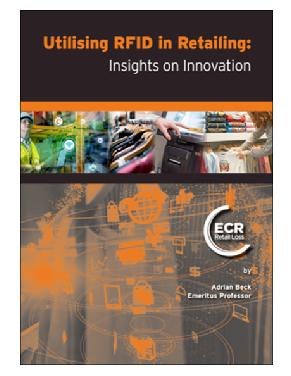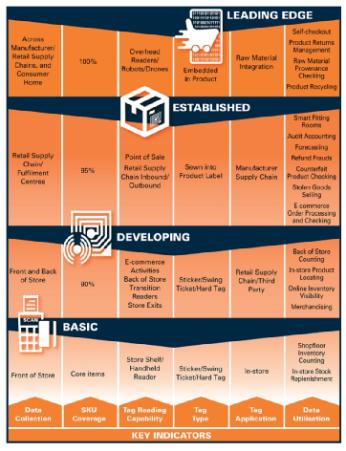Call Us Now
+8615914489090

ECR Retail Loss Group has released a new research report-"The Application of RFID in the Retail Industry: Innovation Insights."
This report is based on a previous study published by the organization in 2018 entitled "Measuring the impact of RFID in the retail industry: key lessons learned from 10 case study companies". Led by Professor Adrian Beck.
The honorary professor of the University of Leicester provides an in-depth understanding of the retailer's development of RFID systems, and at the same time explores the company's innovative development methods. The report is based on an online survey and interviews with multiple companies currently using RFID technology.

According to Baker, the core business case identified in the 2018 study still has a consistent strategy: use handheld readers to inventory retail stores to improve inventory accuracy. The most important reason for the introduction of RFID technology is that it can increase sales, reduce staff costs and inventory costs, and reduce retail losses.
In addition, people have also found that the development of RFID technology in business case innovation is largely gradual. The study found that as companies become more mature in using RFID data, more use cases are gradually added to their regular business (Business As Usual, BAU) practice. These use cases include:
Simplify the inventory process: Studies have shown that the ability to use RFID to collect inventory data means that companies can now use RFID to replace regular and infrequent cycle inventory. Baker said that this saves inventory costs and at the same time has a deeper understanding of inventory management.
Improve store operations: Higher inventory visibility enables users to effectively deal with the problem of fake out-of-stocks, that is, products that are not on the shelves but are available in the back warehouse of the store. RFID improves the speed of product search, which greatly contributes to the omni-channel sales model of shipping from the store.
Smart fitting rooms and magic mirrors: Although these are not yet common, research shows that some companies understand how to use them to create value, especially when measuring their impact through customer satisfaction rather than directly improving profits.

Baker explained that for many retailers, the omni-channel model is now regarded as BAU, and RFID is regarded as the main driver of their distribution process. This manifests itself in:
Use physical stores as distribution centers: Without the inventory accuracy provided by RFID, retailers can hardly believe that their own stores can meet the needs of online orders. For a retailer, only RFID-enabled inventory can be used for online purchases with confidence. On the other hand, stores support RFID functions, which improves inventory turnover, reduces product backlogs and price cuts, and optimizes operating costs.
Improve the accuracy of online orders: Manually organize online orders manually, and errors may occur, which may cause customer complaints and increase the return rate. Retailers use RFID to check merchandise orders, reducing the order error rate and customer complaint rate by 90%.
In the survey, although most people said they use RFID technology in the supply chain, some respondents said that they are cautious about the value that RFID can bring. In this case, the main application of RFID technology is focused on checking the accuracy of incoming and outgoing goods and improving the accuracy of inventory in distribution centers. But when the distribution center is used as an online fulfillment center, RFID creates value for the transformation of this functional process. However, some interviewees believe that using RFID to monitor inventory in the retail supply chain to develop a business case is still challenging.
Only one respondent currently uses RFID for self-checkout (SCO). Part of the reason for this relatively small number of application cases is that 100% of the stock-keeping unit (SKU) needs to be marked and has very high read reliability. In fact, the use of RFID for self-checkout has the following advantages:
Checkout speed: Since RFID does not require direct line of sight to read product identification, it can read all products in large quantities at checkout.
Loss control: The automation of the product identification and registration process makes users no longer have scanning errors, nor will one product be mistakenly registered as another product.
Customer service advantage: RFID significantly reduces the possibility of double scanning, that is, consumers inadvertently scan the same item multiple times. In addition, the report also pointed out that employees in the store who were previously assigned to checkout services can now be rescheduled for more sales services.
Baker said that although no retailer believes that loss reduction is the main reason for their investment in RFID, many retailers report that with the help of RFID technology, they now have more indirect benefits in loss prevention. These benefits include:
Handling fraudulent refunds: By uniquely identifying products, RFID can lock out thieves who return non-purchased products. Baker pointed out that this potential function may change industry rules, but it does require RFID to interact with electronic point of sale (EPOS), determine which RFID tags have not been removed, and develop an effective return strategy.
Enable dynamic product loss analysis: Lack of information about lost items can cause confusion to the loss prevention team. RFID data can clearly show which products are easy to lose, and due to the increase in inventory frequency, the possibility of developing intervention measures can be quickly and accurately evaluated.
Identify stolen products: Among the interviewees, a US retailer used a handheld RFID scanner in an open-air market to check products for sale. RFID data is used to track their origin and check whether they have been stolen.
Baker said that this study introduces the application of RFID in the retail industry, from basic and development methods to more mature application models, and then to application cases that can be regarded as cutting-edge. Research shows that most retailers are currently in the basic and development stage, relatively few retailers have more mature cases, and almost none of them can be considered at the forefront of applications.
Obviously, for many companies adopting RFID, the use of RFID is a gradual process. With the emergence of viable business cases, the application of RFID will further develop. More importantly, RFID data is increasingly regarded as an indispensable "electronic backbone" for many retail users in omni-channel operations around the world.